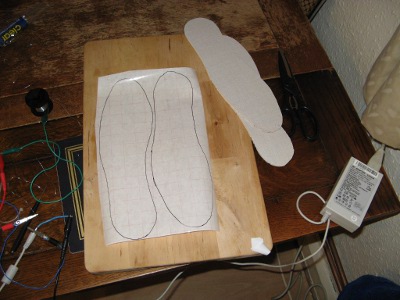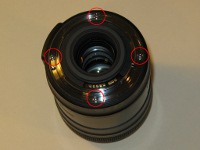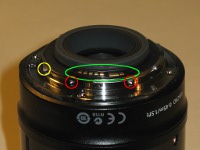Workshop
Electrically heated insoles
It's cold working in an unheated shed with a stone floor in the winter. I was debating installing a proper space heater but realised that the only part of me that actually got cold was my feet, stood on the stone slab in the drafts by the floor. The solution was obvious: electrically heated insoles!
I decided to use some resistance wire taped to the bottom of a normal pair of insoles. I began by tracing the outline of my insoles onto some sticky-backed plastic.
Read more...Published on 15th November 2012.
Fixing the focus on a Canon EFS 18-135mm lens
I managed to break the focusing on my Canon 18-135mm lens recently by smacking it hard against my knee whilst it was around my neck. There's only 3 options at this point:
- Buy a new/second hand lens replacement
- Send the lens in for professional repair
- Try a repair myself
What was broken was that the focus ring wouldn't move through its full range of motion. I could focus on near objects but not far objects and the effect was worse when using the more telephoto portion of the zoom range. The problem was apparent in both auto- and manual-focus modes. In manual focus, I couldn't budge the ring past half way and in auto-focus, the motor would whine with an unusual sound and not manage to move the focus past the same focal range.
Fixing the lens
There are a number of sites which detail fixing other problems on Canon lenses. There is also one site I found which has exploded views and parts lists (see the references section below for full details. Unfortunately, I found no information specific to my lens but unsuprisingly it turns out that mine isn't that different to similar Canon lenses.
Step 1: Removing the lens mount
The first step was to remove the metal lens mount from the back of the lens. Begin by removing the four screws highlighted in the first photo. Now the metal ring is free to move but is still attached because the contact strip (green ring in 2nd photo) is still attached. To remove the contact strip, begin by removing the two screws highlighted red in the 2nd photo. Do not remove the screw highlighted in yellow.
Read more...First published on 12th November 2012 and last modified on 15th November 2012.
Zinc extraction and brass-coating copper coins
There are numerous videos and descriptions on the internet of how to brass-coat copper coins. The effect can be brilliant when done well so here's how I made my own.
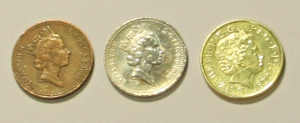
Read more...Published on 13th February 2012.
Repairing a tubular lock
I recently had the misfortune to somehow break my bike lock. It is of a tubular lock design that you often see in vending machines and somehow had rotated to a point where the key could not be put in. The general consensus at this point seems to be to take the lock to a lock-smith. I thought I'd try and repair it myself before that.
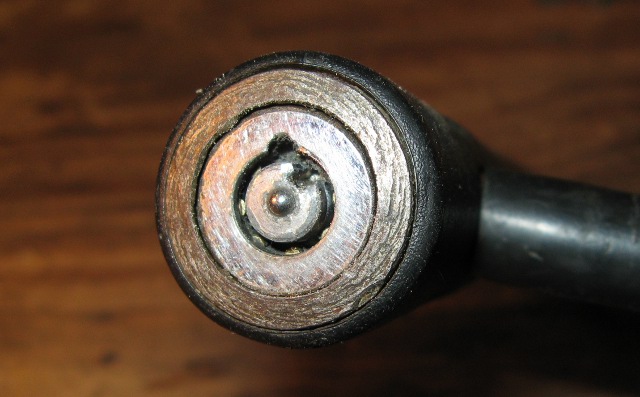
The broken tubular lock. Note the mis-aligned slots.
Read more...Published on 10th July 2011.
Regenerating sealed lead acid batteries
By design sealed lead acid batteries are, by their very nature, sealed. This means that if they have been damaged by ovecharging and have dried out then it is problematic to restore them. Ironically it is possible to do this damage in the first place because they aren't completely sealed. There is a rubber cap on top of each cell. This cap is a snug fit but it is not absolutely sealed. If a lead-acid battery is charged too much then the water contained within them can electrolyse to hydrogen and oxygen. This process is called gassing. If the charging isn't too rapid then the hydrogen and oxygen recombine within the cell and re-form to water: no harm done. However, if the charging is far too rapid, the gases are lost around the rubber caps leading to a lower electrolyte level. Ultimately this can destroy the battery and prevent it from holding a charge at all.
Recently, I had a normally faithful torch give up and die. It wouldn't hold any charge and turned off soon after turning it on. It contained a 12V 7Ah sealed lead acid battery. I took the battery out and decided to see if I could repair it.
Investigating the battery
The first thing I did was to pry off the plastic lid covering the 6 cells. This was held on with just some glue and snapped off relatively easily with some forecful jabbing from a screwdriver. If I'm going to re-attach the lid I'll need either some fresh glue or some tape. With the cover removed, you can easily see the 6 cells and their respective rubber caps. It's around these caps that gases will vent if the battery is overcharged.
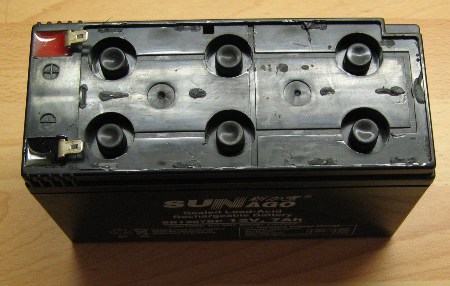
6-cell sealed lead acid battery with its plastic cover prized off
Read more...First published on 30th December 2010 and last modified on 16th March 2011.
< Newer articles | Older articles >
